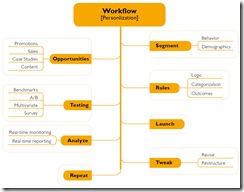5 Principles to consider for online personalization
Web personalization is about delivering targeted content and adaptive web experiences based on what you know about each visitor. For ambitious web marketers looking for the next leap in returns, this is a massive opportunity. Of course, it’s not without risks. Get it wrong, and you’ll confuse visitors, waste resources and depress conversions. But get it right and you’ll surprise and delight your web visitors while driving your website to new levels of effectiveness.
This includes any or all of the following sources of insight:
Their profile and preferences – everything they’ve told you about themselves (if you already know them).
Their history with you – what they’ve done on your site, in your community, in response to your emails, etc.
The way they found you – including the search terms or pay-per-click ads that delivered them, or a tagged URL that they clicked on.
Their immediate behaviors – what they’re doing in the current session (clickstreams, site searches, etc).
The context – including time of day, day of the week, geography and your own strategic agenda (targeted offers, surveys…).
The dynamic environment – real-time factors like the weather and commodity pricing. When the rain falls, you can show ads for umbrellas or raincoats, and when the snow lands, skis and goggles.
Your own personalization efforts can use as much or as little of this kind of insight as you need to drive the content you choose to present in each session.
The point is not to make every session perfectly targeted from day one – just to improve the relevance of each session so the visit is more compelling. As the project proves itself, you can grow your ambition and sophistication.
I have previously blogged on this topic, but have since then expanded my research into the area and have come up with 5 principles that I think are important to consider if you want to get started and succeed with personalization.
1) Start with clear goals and objectives. The best goals are quantifiable, so write them down! Things like demonstrate clear return on investment (ROI) of 50% within six months, increase monthly new lead supply by 30% for nurturing campaigns,boost quarterly campaign quality index (conversions / visits) by 40% and the classic measure personalization impact in Customer Satisfaction Index. Do people feel the “personal” touch is providing a better service?
2) Assemble the right team! The web editors will have day-to-day control of the content and should also contribute to the personalization strategy and execution, your development team will have to know what’s going on at every stage. Consider community owners or your social media team – if you run a forum or social feature, the people who run the community are valuable assets. Product management will have a view on how to personalize the product pages. Sales may want to personalize the key stages of the web funnel and customer may want to personalize the experience for VIP customers. Involvement from the right people is a key factor in your success.
3) Simplicity - Early web personalization efforts stalled because they forced people to use a disconnected series of software platforms, including analytics, CRM, data warehousing, digital asset management, web recommendations engines and content management systems. Use as few software systems as you can
4) Make the workflow simple and move rapidly! Here’s what your workflow needs to do
a. Think about your segments
b. Identify opportunities to personalize
c. Create a rule
d. Test it
e. Go live
f. Analyse the results
g. Tweak
h. Repeat
All this needs to take place in days instead of weeks, so you need to get your people, processes and technology in sync.
5) Start small. Personalization projects die because they try to do too much too soon. Pick one or two of your low-hanging fruit and make them work before moving on to trickier stuff.
a. Returning customers should always be treated like returning customers. Even the smallest acknowledgement that you know who they are goes a long way.
b. Geography can be a simple start to targeting. One hotel chain improved bookings by serving up different offers to visitors from different countries.
c. For B2B marketers, starting with vertical industry targeting is a no-brainer. If you don’t yet know the visitor’s market, you can use an IP-lookup plug-in to find out, in real time.
The guiding principles are speed and iteration. If you consider these 5 steps, then you have a plan that you can execute against. In coming posts, I will look further into the some principles to consider in the actual execution phase. Any comments, feedback and experiences that you can share are most welcome!


Comments